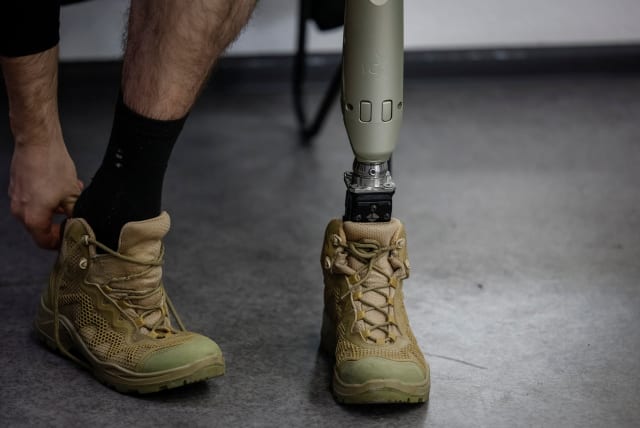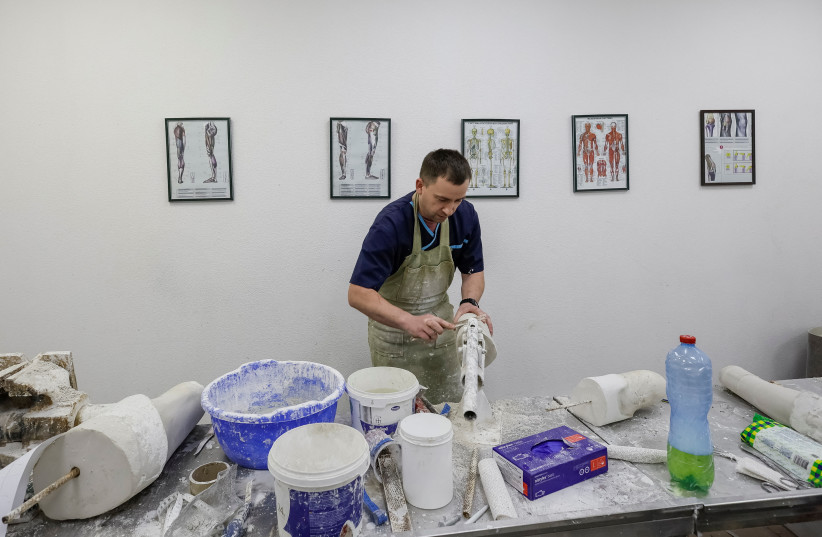Ukraine needs more prosthetics clinicians as war toll mounts

Russia's unrelenting artillery fire and missiles mean that shrapnel wounds are maiming people in Ukraine on a scale just beginning to emerge.
The steady stream of wounded soldiers into a clinic for artificial limbs in Kyiv is a stark reminder of the human cost of Russia's war on Ukraine, where military casualties are a secret closely guarded by both sides.
Unrelenting artillery fire along a 1,000-km (600-mile) front line and Russia's frequent use of missiles across the country mean that shrapnel wounds are maiming people in Ukraine on a scale just beginning to emerge.
"Unfortunately, the number of patients has increased significantly," said Andrii Ovcharenko, who works with a team of medics and technicians at the "Without Limits" prosthetics clinic, one of almost 80 now operating in Ukraine.
Clinic owner Nagender Parashar's Kyiv-based company made about 7,000 prosthetic components in the second half of last year, equal to the total produced in 2021. "It's still not enough," he said.
Parashar has 25 specialists at the nine clinics he owns in Ukraine; the busiest - Kyiv and Lviv - would see 20 to 30 patients a month, but now it is three times that number and he says he needs up to 75 more specialists to cope.
Russia has poured extra troops and artillery into the fight this year and some analysts have compared the months of intense, inconclusive trench warfare in eastern Ukraine to World War I.
"There really is a shortage of prosthetists, because there are a huge number of people requiring prosthetic treatment coming in every day," Ukrainian Health Minister Viktor Liashko told Reuters in an interview.
"Now the priority is upper limbs, so those specialists who deal with this are overloaded."
On a recent morning, Ovcharenko's Kyiv clinic assessed two soldiers for artificial legs and adjusted the new limb of a third. A handful more came for rehabilitation exercises. Staff said a recent Russian missile attack on Kyiv had put others off.
Denys said he lost his left leg when a Russian missile landed 50 meters from his unit in the eastern city of Kramatorsk.
"My comrade behind the dugout received shrapnel wounds and bled to death," the 28-year-old told Reuters as he sat in a wheelchair, declining to give his full name.
He said it was a gift from God that he had survived and there was no sense in complaining. He planned to return to civilian life once he had recuperated. According to Ovcharenko, many amputee soldiers volunteer to return to the war.
Dmytro Zilko had a newly fitted artificial limb to replace his right leg, amputated after a shell landed nearby during fighting in a village close to the eastern town of Bakhmut - where the fiercest battles of the conflict still rage.
"They cut my leg off in Druzhkivka," the 22-year-old said, referring to a town west of Bakhmut. "This is my fourth exercise day. As soon as I stood on my prosthetic leg, I felt alive."
Feet, hands, elbows
Germany's Ottobock - the world's biggest prosthetic equipment maker by market share - sold roughly twice as many foot prosthetics in the second half of 2022 as all of 2021, its CEO Oliver Jakobi told Reuters, attributing the rise to the war.
Before Russia's full-scale invasion 13 months ago, the ratio of lower limbs and upper limbs was about 9 to one, while it was now probably 50-50, he said.
Ukraine has around 300 prosthetists, technicians and apprentices, but only five can fit functional devices like hands and arms, said Antonina Kumka, founder of charity Protez Hub which works with 79 prosthetics clinics across the country, up from 65 in 2021.
Artificial limbs like elbows are in demand, she added, with some people having to wait up to six months to be fitted.
At least 100 patients had been fitted abroad, she said, noting that the practice is not ideal given patients need long-term follow-up.
Experts say Ukraine will need big investment in infrastructure and staff to deal with amputees needing help for years to come: a lower limb prosthetic can cost anywhere from $500 to as much as $70,000 for more sophisticated equipment.
The number of prostheses paid for by Ukraine's Ministry of Social Policy jumped more than 15% to 13,219 in 2022 from a year earlier, according to previously unreported ministry data.
Healing following amputation surgeries before new limbs can be fitted can take up to four months and there is another lag before the government makes a payment.
US Army General Mark Milley estimated in November at least 100,000 Russian military casualties - killed or wounded, with "probably" the same for Ukraine. Some Western officials have suggested that number had doubled on the Russian side by February. Neither side gives updated figures.
Oleksandra Kazarian, CEO of the Ortonet association for prosthetic and orthopedic enterprises in Ukraine, said the numbers treated by one company, Tellus, had risen 20% last year from nearly 600 a year earlier across three clinics. It expects another 30-40% rise in 2023.
It plans to expand, depending on how the war unfolds but is not sure where to open new clinics.
"Where's a safe place?" Kazarian said. "You never know."
Jerusalem Post Store
`; document.getElementById("linkPremium").innerHTML = cont; var divWithLink = document.getElementById("premium-link"); if (divWithLink !== null && divWithLink !== 'undefined') { divWithLink.style.border = "solid 1px #cb0f3e"; divWithLink.style.textAlign = "center"; divWithLink.style.marginBottom = "15px"; divWithLink.style.marginTop = "15px"; divWithLink.style.width = "100%"; divWithLink.style.backgroundColor = "#122952"; divWithLink.style.color = "#ffffff"; divWithLink.style.lineHeight = "1.5"; } } (function (v, i) { });


